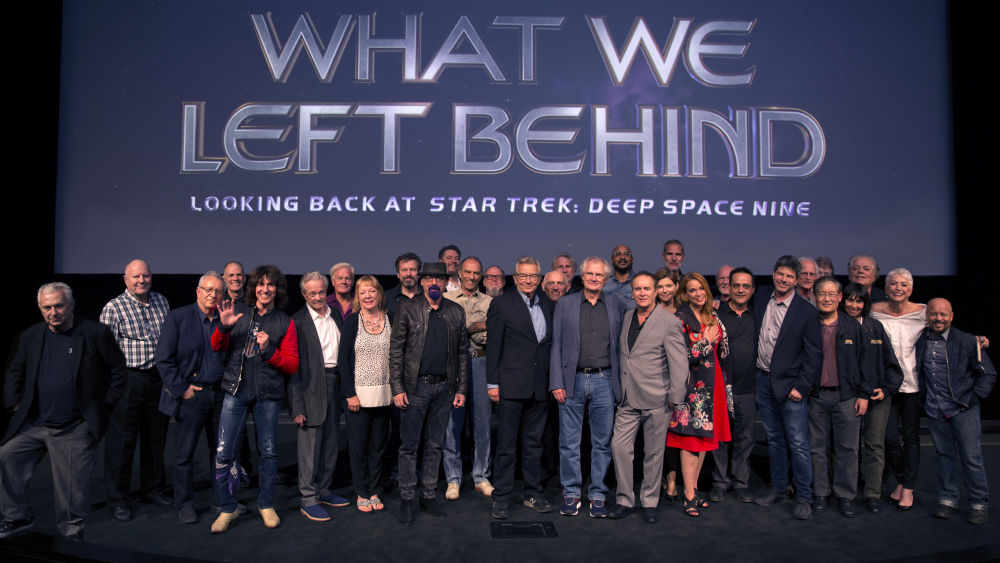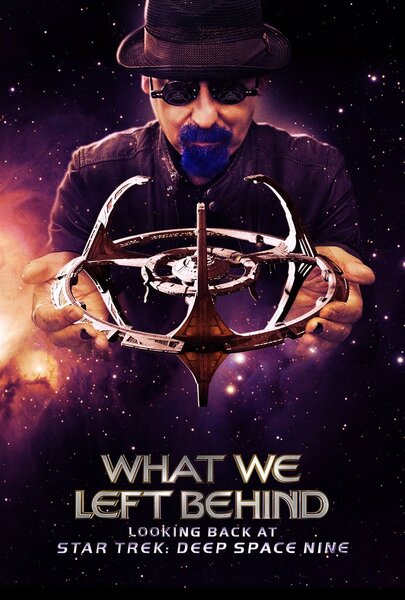Create a free profile to get unlimited access to exclusive videos, sweepstakes, and more!
SDCC: Deep Space Nine cast answers 'What They Left Behind' in new documentary

The critically acclaimed documentary feature What We Left Behind is a behind-the-scenes look at the risks taken by Star Trek's middle child, Deep Space Nine.
Showrunner Ira Steven Behr, filmmaker David Zappone (The Captains) and DS9 cast members Andrew Robinson (Elim Garak), Aron Eisenberg (Nog), Penny Johnson Jerald (Kasidy Yates), Cirroc Lofton (Jake Sisko), and Chase Masterson (Leeta) joined one another on stage to talk about the groundbreaking series. The panel was moderated by Brian Ward (Shout! Factory). A last-minute addition to the panel was producer Kai de Mello- Folsom.
The room was absolutely packed with fans of Deep Space Nine with many more waiting outside for the chance to get in. The cast was introduced to thunderous applause. Brian Ward kicked off the panel by asking filmmaker David Zappone why he decided to focus on DS9. Zappone says this simple answer is, it was his favorite Star Trek series.
What We Left Behind is the fan-funded film that offers us a glimpse into what it took to create the series, hint: it took a lot. Star Trek: Deep Space Nine was a break in the Star Trek franchise. Set aboard a space station orbiting the planet Bajor, DS9 was a far more gritty entry into the ST canon. The documentary also imagines a fictional season 8 premiere with the original writers of the series reuniting.
In Deep Space Nine, there is no USS Enterprise to come and save the day, Captain Benjamin Sisko (Avery Brooks) must cobble together relationships with unlikely allies. Penny Johnson Jerald recalled her onset relationship with Avery Brooks, "One of the keys to what Avery and I did on DS9, is we never found one another when other people weren't around! The chemistry was intense. It was a love affair not just with Avery but with outer space."
Jerald thanked her husband for encouraging her to try out for the role of Kassidy Yates. She did add that he doesn't watch the kissing scenes because they were intense. Brian Ward then introduced a scene not included in the documentary detailing a hilarious prank Cirroc Lofton pulled on Jerald during the filming of her first scene. The prank involved a strategically placed paper towel roll and a pair of Lofton's pants... we think you get the picture!
The cast on stage has a reverence for one another and the series. The cast felt a duty to one another and to what the show represented. For the cast and crew, it's obvious the series was much more than just a job. It was a family and a representation of what people go through. There's a real sense of history, which Behr acknowledged. Andrew Robinson added that he still lives by one of Garak's most famous lines, "Never tell the same lie twice."
When the panelists were asked about what makes the core of Star Trek, Behr summed it up best. "What Gene Rodenberry gave us all is the ability to explore the human condition. The human condition in all of its strengths and failures is really what Star Trek is all about."
In Deep Space Nine, Sisko and crew are in charge of setting up the Bajoran provisional government to help transition the people of Bajor following the brutal occupation by the Cardassians. The wormhole represents wealth and opportunity for any who may seek to control its access into the Gamma Quadrant.
The series premiered in January 1993 and according to Variety, was the "highest-rated series premiere in syndication history." DS9 certainly wasn't afraid to break the rules and it did so at nearly every opportunity. Upsetting the studios, DS9 offered viewers a break from the episodic format of previous Star Trek series. The show was unafraid to tackle thorny issues around war and terrorism. More importantly, what happens after a war ends. This was the first time we see the challenges of attempting to implement the values of Starfleet in a world ravaged by war, colonialism, and occupation.
The crew of DS9 had complex and rich pasts. These were morally ambiguous characters who did what they had to in order to survive. The show was unafraid to display interpersonal conflicts of the crew aboard DS9, a stark departure from its predecessors. As the documentary reveals, the show's writers wanted viewers to not only question who was good and evil but how we arrive at such determinations. DS9 unabashedly tackles issues of race, religion, xenophobia and ultimately what it means to be human
Although DS9 is now twenty-six years old, the story it tells feels as prescient as ever. With What We Left Behind, fans of the show can get an in-depth look at what it took to create the groundbreaking series which continues to influences the Star Trek universe today.
Click here for SYFY WIRE's full coverage of San Diego Comic-Con 2019, including up-to-the-minute news, exclusive interviews, and videos.



























